RHIC Run 24: Science Goals and Accelerator Advances
Highlights include proton-proton smashups, first physics data for sPHENIX, new collisions "seen" by forward detectors at STAR, and more
April 15, 2024
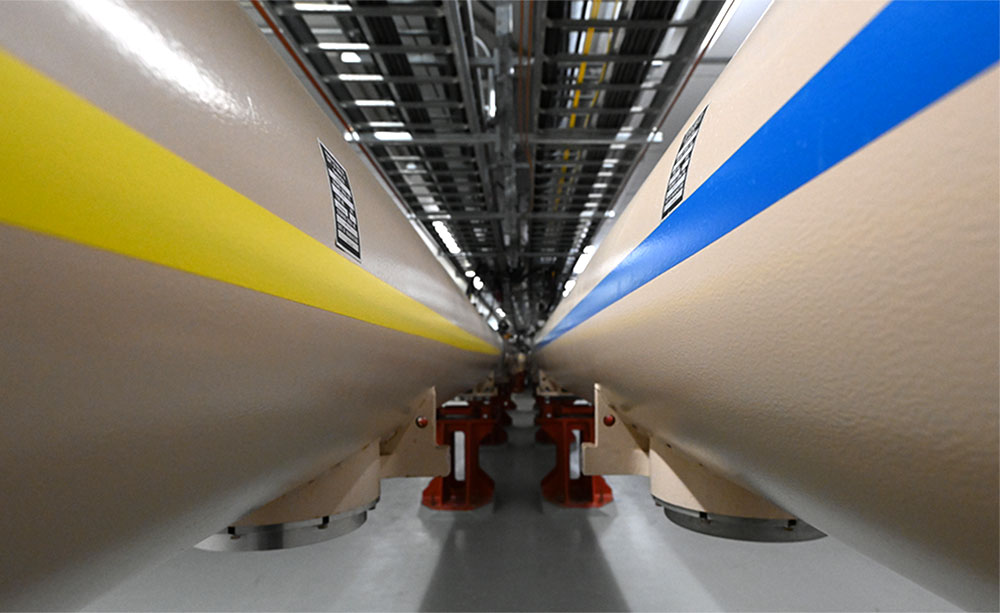 enlarge
enlarge
The twin rings of the Relativistic Heavy Ion Collider (RHIC) will soon begin colliding ions. On the menu for Run 24: collisions of polarized protons followed later by gold-gold smashups. (Kevin Coughlin/Brookhaven National Laboratory)
Today marks the startup of the 24th run of the Relativistic Heavy Ion Collider (RHIC), a U.S. Department of Energy (DOE) Office of Science user facility for nuclear physics research at DOE’s Brookhaven National Laboratory. Physicists at RHIC’s two house-sized particle detectors, sPHENIX and STAR, are eagerly awaiting the first collisions in Run 24 of protons speeding in opposite directions around the accelerator’s twin 2.4-mile-circumference rings.
At RHIC, the protons — positively charged building blocks of atomic nuclei — are polarized, meaning their “spins” are preferentially aligned. By analyzing how certain particles emerge from collisions relative to this spin direction, scientists can explore how a proton’s own internal building blocks — quarks and gluons — contribute to its overall spin.
The proton-proton collisions also provide important comparison data for RHIC’s collisions of larger atomic nuclei. Collisions of nuclei such as gold, consisting of many protons and neutrons, recreate the conditions of the early universe by setting “free” the quarks and gluons that make up the protons and neutrons. Scientists use RHIC to explore detailed properties of the resulting quark-gluon plasma (QGP) and the strong force — the strongest force in nature — which holds quarks together in the matter that makes up our world today.
Collecting comparison proton-proton data in Run 24 is especially important for sPHENIX, a brand-new detector that saw its first gold-gold collisions last year. Run 24 is the second-to-last planned for RHIC before much of its infrastructure is converted into the future Electron-Ion Collider (EIC). Run 25 will be focused on collecting unprecedented amounts of gold-gold collision data.
“Run 24 is our only chance to collect proton-proton data according to the current plan,” said sPHENIX co-spokesperson Gunther Roland, a physicist at Massachusetts Institute of Technology (MIT).
Brookhaven Lab physicist Dave Morrison, the other sPHENIX co-spokesperson, added, “We need the proton-proton baseline to accurately know what’s going on in gold-gold.”
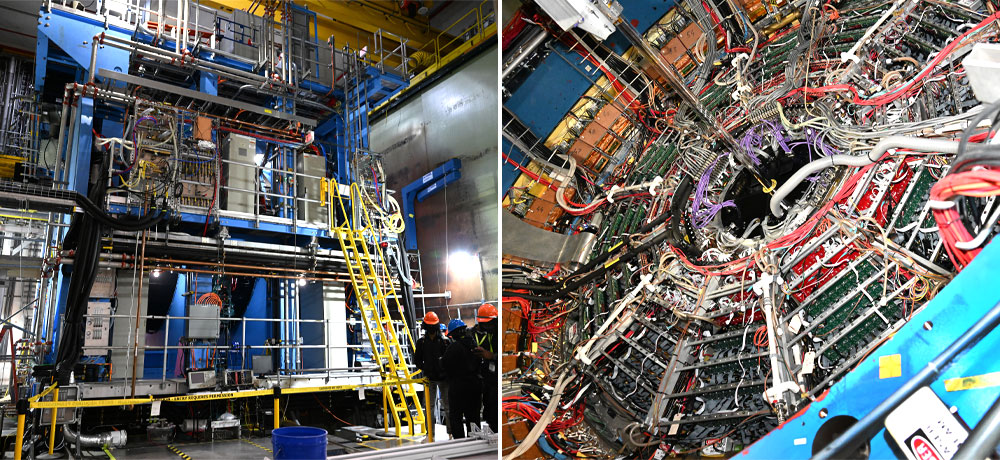 enlarge
enlarge
The sPHENIX and STAR detectors at the Relativistic Heavy Ion Collider (RHIC). (Kevin Coughlin/Brookhaven National Laboratory)
STAR has collected copious proton-proton data in many previous runs. But Run 24 will be the first using recent detector upgrades at the planned collision energy — 200 billion electron volts (GeV). These upgrades will track particles streaming out perpendicular to the direction of the colliding beams, including those very close to the collision point, as well as particles emerging far out in the “forward” direction along the beampipe.
According to STAR co-spokespersons Lijuan Ruan, a physicist at Brookhaven, and Frank Geurts of Rice University, the new detector capabilities will allow STAR physicists to turn qualitative observations into precision conclusions about QGP properties and gain new insight into internal details of the proton’s spin.
“We know that we can expect something exciting in the forward direction,” Geurts said. “This certainly is going to be a very interesting run.”
In addition to 19 planned weeks of proton-proton collisions, there will be six more weeks in the 25-week run. A few of those weeks will be devoted to gold-gold collisions so the sPHENIX collaboration can be sure their detector is ready for next year’s intense gold-gold run. Accelerator physicists will also be continuing accelerator studies that will help inform the design of the EIC.
“We are happy to be starting up the only operating collider in the U.S. and the most versatile collider in the world,” said Michiko Minty, associate chair for accelerators and applications of the Lab’s Collider-Accelerator Department (C-AD).
Upgrades and repairs
The RHIC team is especially eager to get started after an 8 ½-month shutdown during which sPHENIX made some changes to their detector and C-AD made some upgrades and repairs.
A series of electrical repairs were needed after Run 23 was unexpectedly cut short by an electrical arc in a power supply building outside the RHIC ring. The mishap caused a leak of the helium that cools RHIC’s superconducting magnets to a chilly -452 degrees Fahrenheit, which triggered a rapid and controlled shutdown of the accelerator. A detailed inspection revealed that the spark had occurred inside a feedthrough that connects cold superconducting wires with ordinary-temperature external power lines.
“We had an external review by a team of experts from other DOE labs and one from CERN [Europe’s nuclear and particle physics laboratory] where we presented a causal analysis and our path forward, and the committee concurred with our conclusions,” Minty said. The team replaced the damaged feedthrough and implemented changes to prevent excessive temperature variations at the solder joints where warm and cold electrical cables meet — a somewhat more sophisticated version of putting a more efficient thermostat in your house. They also added audio and visual alarms to the existing alarm system for signaling a helium release.
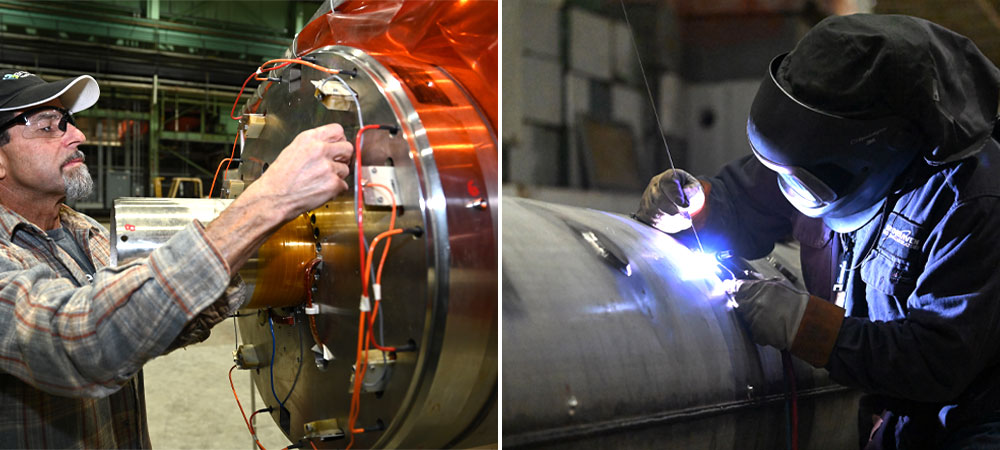 enlarge
enlarge
Workers prepare a replacement magnet that was installed in RHIC during the break between Run 23 and Run 24. (Kevin Coughlin/Brookhaven National Laboratory)
The inspection of electrical systems and magnets also revealed peripheral damage in electrical solder joints on both ends of one of the nearby magnets that merges the beams from RHIC’s two counter-circulating rings into one beampipe outside the interaction regions. While there was no evidence that the magnet itself was damaged, its integrity could not be confirmed until RHIC was cooled down again. So, the team preemptively replaced the magnet with a spare, Minty said.
Diagnosing the electrical failure and planning and executing the recovery was a true C-AD team effort supported by staff from the EIC; the National Synchrotron Light Source II; the Superconducting Magnet Division; Facilities & Operations; Procurement & Property Management; Environment, Safety & Health; and the DOE site office, Minty noted.
In addition, a Siberian snake magnet that had been damaged during power outages in Run 22 was repaired by the Magnet Division and reinstalled. These “corkscrew”-style magnets are essential for maintaining the polarization, or spin alignment, of RHIC’s proton beams.
Improving performance
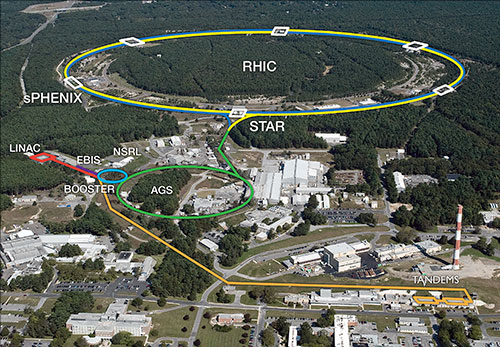 enlarge
enlarge
A chain of accelerators at Brookhaven National Laboratory brings protons or atomic nuclei up to speed and injects them into the counter-circulating "gold" and "blue" rings of the Relativistic Heavy Ion Collider (RHIC). Pairs of protons or ions collide at the center of two house-sized detectors, STAR and sPHENIX. Scientists analyze particles streaming out of collisions to learn about the building blocks of matter.
C-AD physicists and engineers have made some other improvements that should boost the accelerator’s performance for Run 24 and beyond. For example:
- The electron beam ion source (EBIS), which prepares gold and other ions for RHIC by stripping off electrons to begin the acceleration process, can now deliver ions from helium to uranium. C-AD also made changes so EBIS can supply polarized helium-3, an ion species that will be essential for the future EIC. The EBIS upgrades should increase gold ion beam intensity by up to 40%.
- New “skew quadrupole” magnets have been installed in the Alternating Gradient Synchrotron (AGS) to compensate for depolarizing effects in the particle beams fed into RHIC. These should help boost the beams’ polarization — the degree to which particles within an accelerated bunch are aligned in a chosen direction.
- A superconducting radiofrequency cavity last used in 2016 will be recommissioned this year and used next year to squeeze beams of gold ions longitudinally. Keeping the bunches of billions of gold ion beams shorter from front to back packs the particles more closely together. That increases the potential for collisions when the two beams cross. Short ion bunches will be particularly important for sPHENIX, which has the most coverage from a range of particle tracking systems right at the center of their detector.
“Having shorter bunches — and steering them into collisions with a ‘crossing angle’ between the opposing beams — ensures that most collisions happen in this high-coverage zone while keeping extraneous particle tracks from overloading other detector systems,” said Kiel Hock, the RHIC run coordinator for Run 24.
The Lab has also made improvements in conventional infrastructure to keep RHIC buildings cool during summertime operations.
sPHENIX up and running
Even with Run 23 — and therefore sPHENIX’s commissioning, or “system shakedown” — cut short, the new, state-of-the-art detector performed extremely well.
“To go from a brand-new, just-installed collider detector to any expectation that you might get physics with it in the amount of time that sPHENIX did is unprecedented,” Morrison said.
Still, the sPHENIX team identified a few things that can potentially be improved. So, during the break between Runs 23 and 24, they made some changes.
One significant update is in the way the detector’s time projection chamber is wired to track particles as they interact with gas inside. Originally, a series of high-voltage wires and the resistors that supply current were installed right on the detector. But because sPHENIX is structured in layers, somewhat like an onion, when other detector components are installed and everything is operating, this area is completely inaccessible.
“If something was not behaving quite right, there was not much you could do about it,” Morrison said.
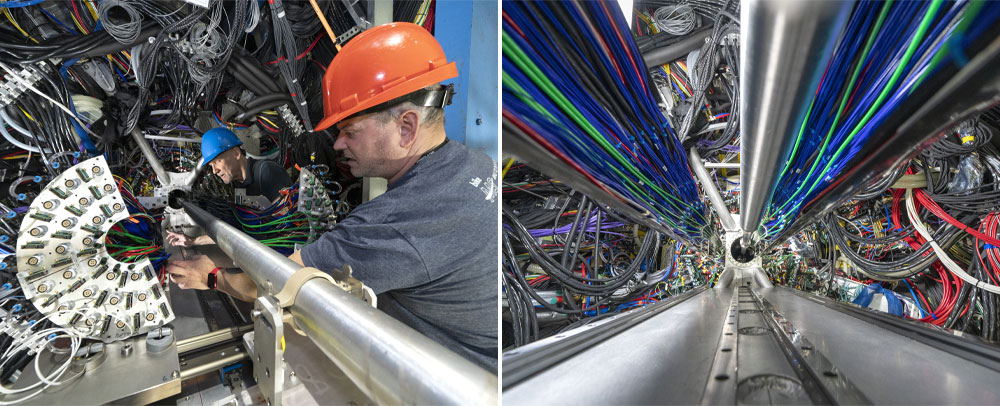 enlarge
enlarge
Re-installation of the MAPS-based VerTeX (MVTX) detector, part of the sPHENIX experiment at Brookhaven Lab's Relativistic Heavy Ion Collider (RHIC), after changes were made to improve access to read-out electronics previously installed on the detector's time projection chamber. (Jessica Rotkiewicz/Brookhaven National Laboratory)
The team decided to connect these components to cables that can now be accessed from the outside. To make the switch, they first had to remove the detector’s most delicate internal components, reconfigure sensitive electronics, and then put everything back together.
“This was very delicate work,” Morrison said. “But it looks like it has paid off.”
Roland noted that for Run 24, “C-AD plans to try to deliver higher proton-proton luminosity, or collision rates, than ever before at 200 GeV. If everything goes as planned, sPHENIX might just be able to collect what we’ve discussed as the minimal necessary number of collisions in the 19 weeks of proton-proton running.”
At some point during the run, sPHENIX physicists will use a few weeks of gold-gold collisions to finish commissioning their detector for optimal collection of the massive gold-gold data set expected in 2025.
One sPHENIX goal for this conclusion to commissioning is to test a strategy for mitigating background signals observed during last year’s gold-gold collisions. The scientists suspect that stray signals could be coming from particles outside RHIC’s beampipe that make it into the detector through a small opening in the detector’s giant steel doors just around the beampipe.
As a potential fix, they’ll bolt several hundred pounds of stainless steel around the half circular openings in the doors so that, when the doors are closed, “there will be something like a collar around the beampipe,” Morrison said.
The idea is for the collar to block stray particles from getting in. “But we have to try it out by doing some studies during gold-gold collisions — with the collar on and with it off — to make sure it makes things better, not worse,” he added.
Throughout the run, the physicists will also be putting sPHENIX’s data acquisition systems to the test. Instead of developing criteria ahead of time that “trigger” the detector to record certain events, sPHENIX will read out data as a continuous stream.
“This is the modern way of taking data,” Morrison said. “Instead of triggers, you use a range of computational techniques to make sure the information from one detector system and another are coming from the same event. It’s more efficient and gives you access to physics you might not otherwise be able to record.”
As Roland noted, some of these data acquisition systems, which make use of online AI technology, were developed specifically with an eye to the EIC. “These tools will allow us to select or tag events within that stream of data that contain particularly interesting signatures — so we know where they are without having to go through the entire data set,” he said.
“Developments that we are pioneering will be used in the EIC,” he added.
STAR to see more than ever before
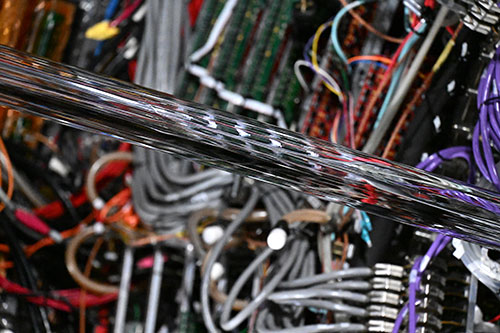 enlarge
enlarge
A close-up of the RHIC beampipe as it enters the STAR detector. (Kevin Coughlin/Brookhaven National Laboratory)
For Run 24 (and 25), STAR will also be tracking more data than ever before and laying groundwork for the physics at the future EIC. The detector’s electronics will read out 5,000 collisions per second — more than double its previous rate. Hardware triggers will still select which events to record, but machine learning and other AI tools will play a major role in the physics analyses to make sense of the recorded data.
In the proton-proton collisions of Run 24, the particles will be transversely polarized — meaning the axes of their intrinsic angular momentum, or spin, will be pointing perpendicular to their direction of travel. As explained in a story about Run 22, tracking asymmetries in the way certain particles emerge relative to a proton’s spin axis can offer deep insights into how its properties depend on the dynamic motions of the quarks and gluons within. That internal motion of quarks and gluons is expected to make a significant contribution, for example, to proton spin.
“If we know the initial polarization of the proton and its three main ‘valence’ quarks, this allows us to use that as a frame of reference to access information related to the quarks’ dynamic motion,” Geurts said.
STAR’s forward detector upgrades will add even more details to the story.
“We’ll be able to look for asymmetries in all sorts of particles in our forward detectors — neutral pions, charged hadrons, direct photons, and collimated jets of particles that emerge from the energy of single quarks or gluons,” Ruan said. They’ll even be able to look for asymmetries within those jets — whether one type of particle emerges with a directional preference with respect to the axis of the jet, say.
“Comparing what we see at mid-rapidity — at right angles to the colliding beams — with what we see in the forward detectors will also help us distinguish the interplay of initial state effects (the state of the protons at the instant of the collision) and final state effects that result from the transformation of quarks and gluons into other particles.”
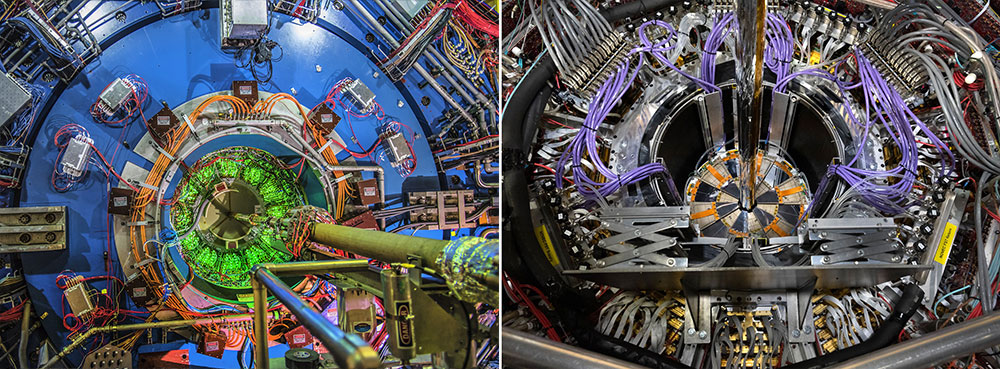 enlarge
enlarge
Forward components of the STAR detector will help scientists make precision measurements. (Roger Stoutenburgh/Brookhaven National Laboratory)
The forward detectors also give scientists the ability to measure the spin contributions of quarks that carry different “fractions” of the proton’s overall momentum. These measurements by STAR will provide a more complete picture of how the various contributions add up.
Gold-gold collisions during Run 24 will help STAR, like sPHENIX, make up for the shortened Run 23. STAR’s goal for Runs 23-25 is to collect close to 20 billion high-quality “minimum bias” gold-gold events. The data collected will feed a rich array of physics analyses. In Run 23, STAR collected 6.5 billion events.
“We were just a few weeks into seeing the benefits of our increased data readout rates when Run 23 ended,” Geurts said.
The collaboration also has certain specific types of events they’d like to select from gold-gold collisions using triggers. Experiments with those specialized triggers had not yet kicked into high gear when the run shut down.
“Now, with a data acquisition system that can easily take twice as high a rate of data as before, we could be quickly back on track to recoup lost time and get more than four billion minimum bias gold-gold events — and also get all the specialty triggers collecting data for all the other analyses this year,” Geurts said.
As RHIC Run 24 run coordinator Hock concluded, “We in C-AD will seek to provide the highest quality data possible — both through regular optimizations and all the aforementioned improvements. With each experiment running in multiple configurations to make the most out of that data, this will be an exciting run with exciting physics.”
Brookhaven National Laboratory is supported by the Office of Science of the U.S. Department of Energy. The Office of Science is the single largest supporter of basic research in the physical sciences in the United States and is working to address some of the most pressing challenges of our time. For more information, visit science.energy.gov.
Follow @BrookhavenLab on social media. Find us on Instagram, LinkedIn, X, and Facebook.
2024-21826 | INT/EXT | Newsroom









